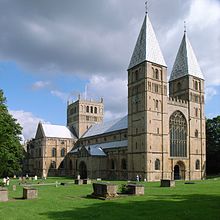
Minster is an honorific title given to particular churches in England, most notably York Minster in Yorkshire, Westminster Abbey in London and Southwell Minster in Nottinghamshire.
The term minster is first found in royal foundation charters of the 7th century, when it designated any settlement of clergy living a communal life and endowed by charter with the obligation of maintaining the daily office of prayer. Widespread in 10th-century England, minsters declined in importance with the systematic introduction of parishes and parish churches from the 11th century onwards. The term continued as a title of dignity in later medieval England, for instances where a cathedral, monastery, collegiate church or parish church had originated with an Anglo-Saxon foundation.
Eventually a minster came to refer more generally to "any large or important church, especially a collegiate or cathedral church".[1] In the 21st century, the Church of England has designated additional minsters by bestowing the status on certain parish churches, the most recent elevation to minster status being St Mary Magdalene church in Taunton, Somerset on 13 March 2022,[2] bringing the total number of current Church of England minsters to 31 (listed below), with almost half found in the Yorskhire and the Humber region and with Dorset and Devon as other areas with many historic minsters.
The term also exists in German as "Münster" and is used mainly for Protestant churches. The German term can be used for some Roman Catholic churches, such as the Strasbourg Cathedral.
- ^ Cite error: The named reference
oedwas invoked but never defined (see the help page). - ^ "St Mary's becoming a Minster church". St Mary Magdalene Church. 5 February 2022. Retrieved 21 April 2022.